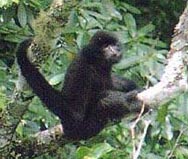Black Gibbon
(Hylobates concolor)
Habitat: tropical and sub-tropical forests.
Feeding habits: pick up young leaves and fruits or catch small animals with its hands.
Food: young leaves of vegetation, fruits, insects and small birds.
Size: with a body length of 43-45 cm.
Habits: It's a kind of man-like ape with higher evolution level in primates. Their tails have disappeared and they act in family clan groups. Each family clan will occupy a piece of forest as their territory. The female ape will utter very long and loud crying each morning. Then, the male ape will cry in antiphonal style or sing in chorus, with some resonance. At last, the young apes also join the chorus. This special crying will last more than 10 minutes or more. The cry is quite touching and could be heard miles away. They do this to defend their territory and to warn nearby ape groups. But such cries expose themselves totally and give the hunters a chance to kill them. Black gibbons live in trees strictly, which enables them to develop an endemic movement method with "arms". They hang themselves on the trees and move forward by stagger their two arms one after the other, and their moving is like playing on the swing. Relying on the swing of the branches and the inertia of the body, they swing faster and faster. They can swing as long as more than 10 m at one time, as if they are flying among the branches. It's said that black gibbons can also catch flying birds in this way.
Category: mammalia, primate, gibbon.
Distribution: middle and Southwest of Yunnna and Hainan Island, China.
Level of protection: class I key state protection animal of China.


|